Yield Data Provide New Insight into the Dynamic Evaluation of Maize’s Climate Suitability: A Case Study in Jilin Province, China
Abstract
1. Introduction
2. Materials and Methods
2.1. Study Area
2.2. Data
2.3. Evaluation Approach
2.3.1. Maize Cultivation Patterns and Climate Indices
2.3.2. Meteorological Yield
2.3.3. Yield-Based Refinement of Factor Suitability
2.3.4. Definition of the Evaluation Function
2.3.5. Validation of the Suitability Evaluation
2.4. Analysis of the Climatic Limiting Factors
3. Results
3.1. Temporal and Spatial Changes in Cultivation Patterns and Yield
3.2. Climatic Suitability of Maize
3.2.1. Yield-Based Refinement of Factor Suitability and Validation
3.2.2. Temporal and Spatial Changes in Climate Suitability
3.3. The Relationship between Cultivation Patterns, Yield, and Climate Suitability
3.4. Analysis of Factors Limiting Climate Suitability
4. Discussion
4.1. Improvement of the Climate Suitability Assessment Approach
4.2. The Influence of Climate Change on the Climate Suitability Of Maize
5. Conclusions
Author Contributions
Funding
Acknowledgments
Conflicts of Interest
References
- Trnka, M.; Olesen, J.E.; Kersebaum, K.C.; SkjelvÅg, A.O.; Eitzinger, J.; Seguin, B.; Peltonen-Sainio, P.; RÖtter, R.; Iglesias, A.; Orlandini, S.; et al. Agroclimatic conditions in Europe under climate change. Glob. Chang. Biol. 2011, 17, 2298–2318. [Google Scholar] [CrossRef]
- Lobell, D.B.; Asner, G.P. Climate and management contributions to recent trends in U.S. agricultural yields. Science 2003, 299, 1032. [Google Scholar] [CrossRef] [PubMed]
- Ciais, P.; Reichstein, M.; Viovy, N.; Granier, A.; Ogee, J.; Allard, V.; Aubinet, M.; Buchmann, N.; Bernhofer, C.; Carrara, A.; et al. Europe-wide reduction in primary productivity caused by the heat and drought in 2003. Nature 2005, 437, 529–533. [Google Scholar] [CrossRef] [PubMed]
- Wei, T.; Cherry, T.L.; Glomrod, S.; Zhang, T. Climate change impacts on crop yield: Evidence from China. Sci. Total Environ. 2014, 499, 133–140. [Google Scholar] [CrossRef] [PubMed]
- Lobell, D.B.; Burke, M.B.; Tebaldi, C.; Mastrandrea, M.D.; Falcon, W.P.; Naylor, R.L. Prioritizing climate change adaptation needs for food security in 2030. Science 2008, 319, 607–610. [Google Scholar] [CrossRef]
- Chen, C.; Qian, C.; Deng, A.; Zhang, W. Progressive and active adaptations of cropping system to climate change in Northeast China. Eur. J. Agron. 2012, 38, 94–103. [Google Scholar] [CrossRef]
- Intergovernment Panel on Climate Change. Intergovernmental Panel on Climate Change Climate Change 2007 Fourth Assessment Report; Cambridge University Press: Cambridge, UK, 2007.
- Zhao, J.; Yang, X.; Liu, Z.; Lv, S.; Wang, J.; Dai, S. Variations in the potential climatic suitability distribution patterns and grain yields for spring maize in Northeast China under climate change. Clim. Chang. 2016, 137, 29–42. [Google Scholar] [CrossRef]
- Meng, Q.F.; Hou, P.; Wu, L.; Chen, X.P.; Cui, Z.L.; Zhang, F.S. Understanding production potentials and yield gaps in intensive maize production in China. Field Crops Res. 2013, 143, 91–97. [Google Scholar] [CrossRef]
- Liu, Z.; Yang, X.; Chen, F.; Wang, E. The effects of past climate change on the northern limits of maize planting in Northeast China. Clim. Chang. 2013, 117, 891–902. [Google Scholar] [CrossRef]
- Zhao, J.; Yang, X.; Lv, S.; Liu, Z.; Wang, J. Variability of available climate resources and disaster risks for different maturity types of spring maize in Northeast China. Reg. Environ. Chang. 2014, 14, 17–26. [Google Scholar] [CrossRef]
- Wang, X.; Peng, L.; Zhang, X.; Yin, G.; Zhao, C.; Piao, S. Divergence of climate impacts on maize yield in Northeast China. Agric. Ecosyst. Environ. 2014, 196, 51–58. [Google Scholar] [CrossRef]
- Thornton, P.K.; Ericksen, P.J.; Herrero, M.; Challinor, A.J. Climate variability and vulnerability to climate change: A review. Glob. Chang. Biol. 2015, 20, 3313–3328. [Google Scholar] [CrossRef]
- Na, L.; Na, R.; Zhang, J.; Tong, S.Q.; Shan, Y.; Ying, H.; Li, X.Q. Vegetation Dynamics and Diverse Responses to Extreme Climate Events in Different Vegetation Types of Inner Mongolia. Atmosphere 2018, 9, 10. [Google Scholar] [CrossRef]
- Tao, F.; Yokozawa, M.; Zhang, Z. Modelling the impacts of weather and climate variability on crop productivity over a large area: A new process-based model development, optimization, and uncertainties analysis. Agric. For. Meteorol. 2009, 149, 831–850. [Google Scholar] [CrossRef]
- Guo, Y.; Li, X.; Zhao, Z.; Nawaz, Z. Predicting the impacts of climate change, soils and vegetation types on the geographic distribution of Polyporus umbellatus in China. Sci. Total Environ. 2019, 648, 1–11. [Google Scholar] [CrossRef] [PubMed]
- Anderson, R.P. A framework for using niche models to estimate impacts of climate change on species distributions. Ann. N. Y. Acad. Sci. 2013, 1297, 8–28. [Google Scholar] [CrossRef] [PubMed]
- Herrera, J.P.; Borgerson, C.; Tongasoa, L.; Andriamahazoarivosoa, P.; Rasolofoniaina, B.J.R.; Rakotondrafarasata, E.R.; Randrianasolo, J.L.R.R.; Johnson, S.E.; Wright, P.C.; Golden, C.D. Estimating the population size of lemurs based on their mutualistic food trees. J. Biogeogr. 2018, 45, 2546–2563. [Google Scholar] [CrossRef]
- Lamsal, P.; Kumar, L.; Aryal, A.; Atreya, K. Invasive alien plant species dynamics in the Himalayan region under climate change. Ambio 2018, 47, 697–710. [Google Scholar] [CrossRef]
- Austin, M.P.; Van Niel, K.P. Improving species distribution models for climate change studies: Variable selection and scale. J. Biogeogr. 2011, 38, 1–8. [Google Scholar] [CrossRef]
- Storlie, C.J.; Phillips, B.L.; VanDerWal, J.J.; Williams, S.E. Improved spatial estimates of climate predict patchier species distributions. Divers. Distrib. 2013, 19, 1106–1113. [Google Scholar] [CrossRef]
- Yin, X.; Olesen, J.E.; Wang, M.; Ozturk, I.; Zhang, H.; Chen, F. Impacts and adaptation of the cropping systems to climate change in the Northeast Farming Region of China. Eur. J. Agron. 2016, 78, 60–72. [Google Scholar] [CrossRef]
- Zhao, J.; Guo, J.; Xu, Y.; Mu, J. Effects of climate change on cultivation patterns of spring maize and its climatic suitability in Northeast China. Agric. Ecosyst. Environ. 2015, 202, 178–187. [Google Scholar] [CrossRef]
- Adejuwon, J. Assessing the suitability of the epic crop model for use in the study of impacts of climate variability and climate change in West Africa. Singap. J. Trop. Geogr. 2005, 26, 44–60. [Google Scholar] [CrossRef]
- Zhao, J.; Yang, X. Distribution of high-yield and high-yield-stability zones for maize yield potential in the main growing regions in China. Agric. Forest Meteorol. 2018, 248, 511–517. [Google Scholar] [CrossRef]
- Holzkamper, A.; Calanca, P.; Fuhrer, J. Identifying climatic limitations to grain maize yield potentials using a suitability evaluation approach. Agric. Forest Meteorol. 2013, 168, 149–159. [Google Scholar] [CrossRef]
- Zhao, J.; Guo, J.; Mu, J. Exploring the relationships between climatic variables and climate-induced yield of spring maize in theast China. Agric. Ecosyst. Environ. 2015, 207, 79–90. [Google Scholar] [CrossRef]
- Tao, F.; Zhang, Z.; Zhang, S.; Rötter, P.R.; Shi, W.J.; Xiao, D.P.; Liu, Y.J.; Wang, M.; Liu, F.S.; Zhang, H. Historical data provide new insights into response and adaptation of maize production systems to climate change/variability in China. Field Crops Res. 2016, 185, 1–11. [Google Scholar] [CrossRef]
- Mourad, M.; Bertrand-Krajewski, J.L.; Chebbo, G. Calibration and validation of multiple regression models for stormwater quality prediction: Data partitioning, effect of dataset size and characteristics. Water Sci. Technol. 2005, 52, 45–52. [Google Scholar] [CrossRef][Green Version]
- Qiu, M.J.; Guo, Q.; Guo, C.M. Temporal and spatial distribution characteristics of spring maize agro-climatic resources suitability in Jilin province. J. Meteor. Environ. 2018, 34, 82–91. (In Chinese) [Google Scholar]
- El-Maayar, M.; Lange, M.A. A Methodology to Infer Crop Yield Response to Climate Variability and Change Using Long-Term Observations. Atmosphere 2013, 4, 365–382. [Google Scholar] [CrossRef]
- Zhu, X.; Xu, Q.; Tang, M.; Li, H.J.; Liu, F.Z. A hybrid machine learning and computing model for forecasting displacement of multifactor-induced landslides. Neural Comput. Appl. 2018, 30, 3825–3835. [Google Scholar] [CrossRef]
- Wang, G.; Lu, J.; Chen, K.; Wu, X. Exploration of Method in Separating Climatic Output Based on HP Filter. Chin. J. Agrometeorol. 2014, 35, 195–199. [Google Scholar]
- Guo, J.P.; Ma, S.Q. Theory and Practice of Monitoring and Prediction of Low Temperature and Cold Damage of Crops. China Meteorol. Press. 2009, 11, 53–55. (In Chinese) [Google Scholar]
- Frank, N.; Richard, N. A fast deterministic smallest enclosing disk approximation algorithm. Inf. Process. Lett. 2005, 93, 263–268. [Google Scholar]
- China Meteorological Administration. Available online: http://www.cma.gov.cn/root7/auto13139/201612/t20161213_349521.html (accessed on 24 February 2019).
- Liu, G.C.; Yang, C.B.; Liu, W.S.; Ding, J.H. Research and Application of Agricultural Climate Suitability Division Based on Fuzzy Mathematics. J. Jilin Agric. Univ. 2007, 29, 460–463. [Google Scholar]
- FAO. Early Agrometeorological Crop Yield Assessment. FAO Plant Production and Protection; Food and Agricultural Organization: Rome, Italy, 1986; Volume 73, 155p. [Google Scholar]
- Willmott, C.J. On the validation of models. Phys. Geogr. 1981, 2, 184–194. [Google Scholar] [CrossRef]
- Wang, R.; Zhang, J.Q.; Guo, E.L.; Li, D.J.; Ha, S.; A, L.S. Spatiotemporal characteristics of drought and waterlogging during maize growing season in mid-western Jilin province for recent 55 years. J. Nat. Disasters 2018, 27, 186–197. (In Chinese) [Google Scholar]
- Cai, J.J. Risk assessment of maize drought and chilling in Northeast China. Master’s Thesis, Chinese Academy of meteorological Sciences, Beijing, China, 2013. [Google Scholar]
- Xia, L.K.; Qiao, J.F.; Zhu, W.H. A book understands corn high yield and disaster prevention and mitigation techniques. Zhongyuan Farmers Publ. House 2016, 5, 31–32. (In Chinese) [Google Scholar]
- Zhang, Q.; Zhang, J.; Guo, E.; Yan, D.H. The impacts of long-term and year-to-year temperature change on corn yield in China. Theor. Appl. Climatol. 2015, 119, 77–82. [Google Scholar] [CrossRef]
- Badr, G.; Hoogenboom, G.; Moyer, M.; Markus, K.; Rupp, R.; Davenport, J. Spatial suitability assessment for vineyard site selection based on fuzzy logic. Precis. Agric. 2018, 19, 1–22. [Google Scholar] [CrossRef]
- Tigkas, D.; Vangelis, H.; Tsakiris, G. Drought characterisation based on an agriculture-oriented standardised precipitation index. Theor. Appl. Climatol. 2019, 135, 1435–1447. [Google Scholar] [CrossRef]
- Than, N.T.; Qiu, J.J.; Verdoodt, A.; Li, H.; Van Ranst, E. Temperature and Precipitation Suitability Evaluation for the Winter Wheat and Summer Maize Cropping System in the Huang-Huai-Hai Plain of China. Agric. Sci. Chin. 2011, 10, 275–288. [Google Scholar] [CrossRef]
- Li, Z.; Tan, J.; Tang, P.; Chen, H.; Zhang, L.; Liu, H.; Wu, W.; Tang, H.; Yang, P.; Liu, Z. Spatial distribution of maize in response to climate change in northeast China during 1980-2010. J. Geogr. Sci. 2016, 26, 3–14. [Google Scholar] [CrossRef]
- Zhao, J.; Zhan, X.; Jiang, Y.; Xu, J. Variations in climatic suitability and planting regionalization for potato in northern China under climate change. PLoS ONE 2018, 13, 9. [Google Scholar] [CrossRef]
- Ji, Y.; Zhou, G.; He, Q.; Wang, L.X. The Effect of Climate Change on Spring Maize (Zea mays L.) Suitability across China. Sustainability 2018, 10, 10. [Google Scholar] [CrossRef]
- Schlenker, W.; Roberts, M.J. Nonlinear effects of weather on corn yields. Rev. Agr. Econ. 2006, 28, 39. [Google Scholar] [CrossRef]
- Schlenker, W.; Roberts, M.J. Nonlinear temperature effects indicate severe damages to US crop yields under climate change. Proc. Natl. Acad. Sci. 2009, 106, 15594–15598. [Google Scholar] [CrossRef]
- Tuck, G.; Glendining, M.J.; Smith, P.; House, J.I.; Wattenbach, M. The potential distribution of bioenergy crops in Europe under present and future climate. Biomass Bioenergy 2006, 30, 183–197. [Google Scholar] [CrossRef]
- Odgaard, M.V.; Bocher, P.K.; Dalgaard, T.; Svenning, J.C. Climatic and non-climatic drivers of spatiotemporal maize-area dynamics across the northern limit for maize production-A case study from Denmark. Agric. Ecosyst. Environ. 2011, 142, 291–302. [Google Scholar] [CrossRef]
- Wang, X.Y. Research on the Evolution Trend of Regional Accumulated Temperature Zone in China. Master’s Thesis, East China Normal University, Beijing, China, 2015. [Google Scholar]

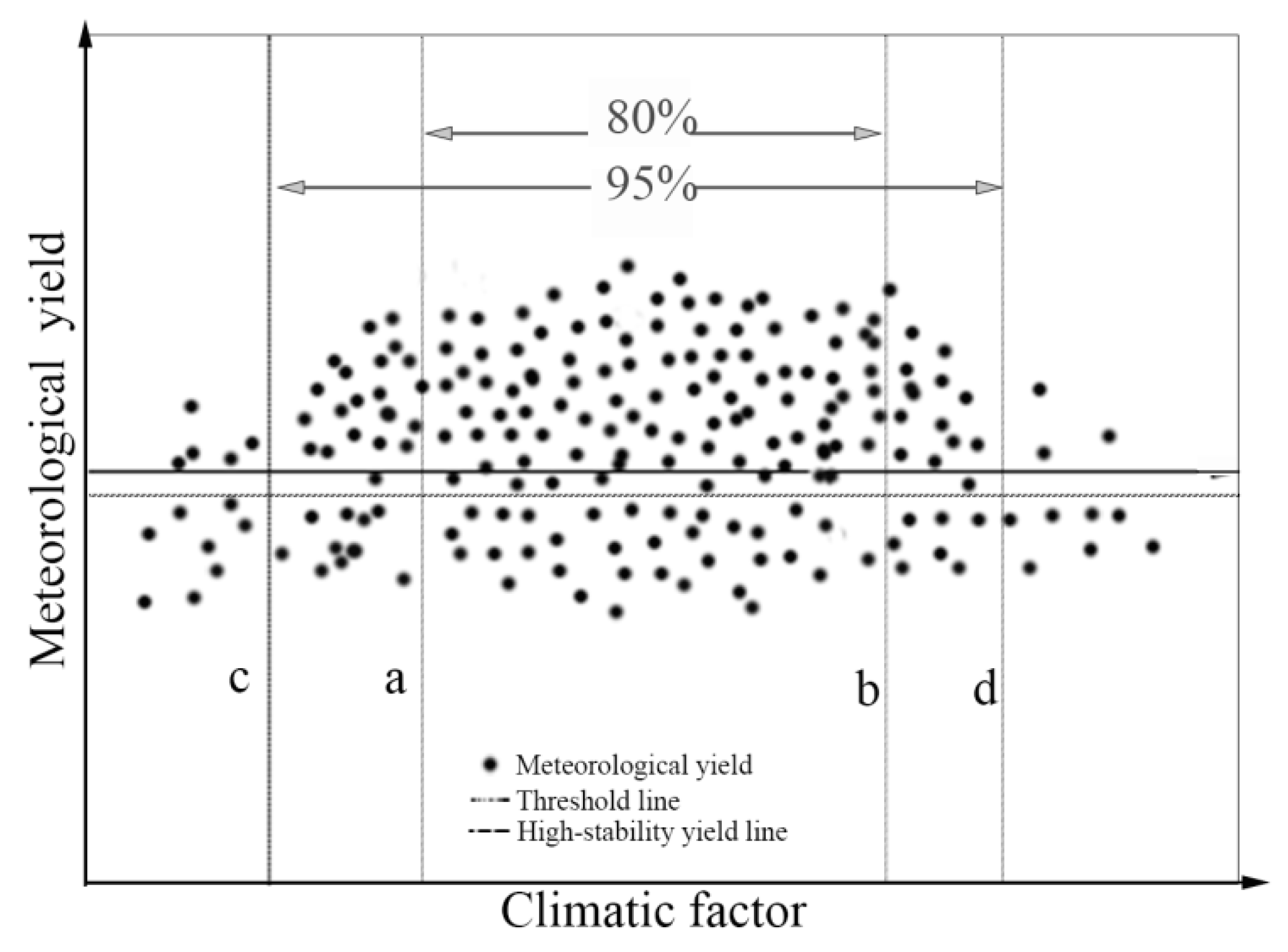
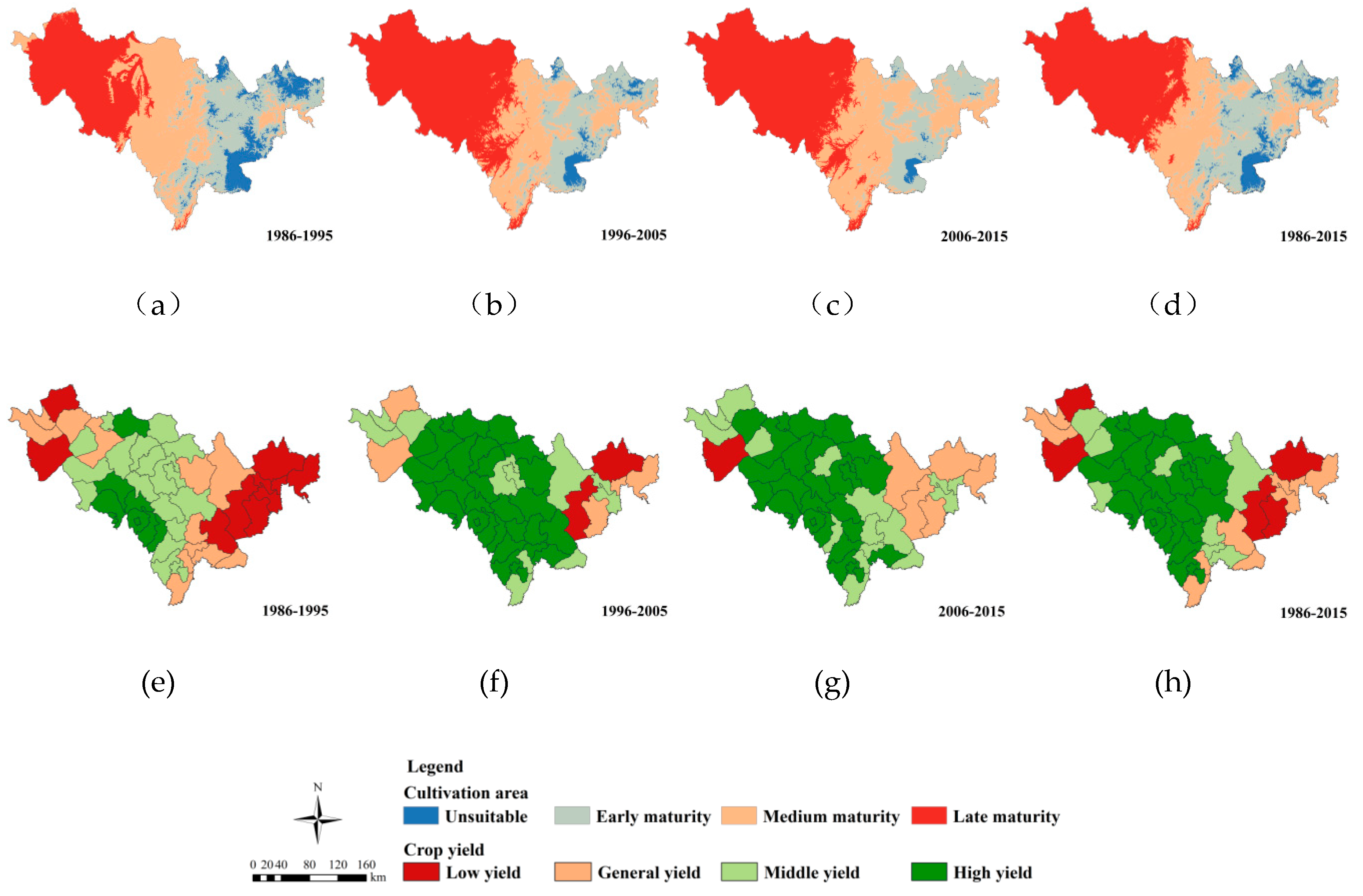

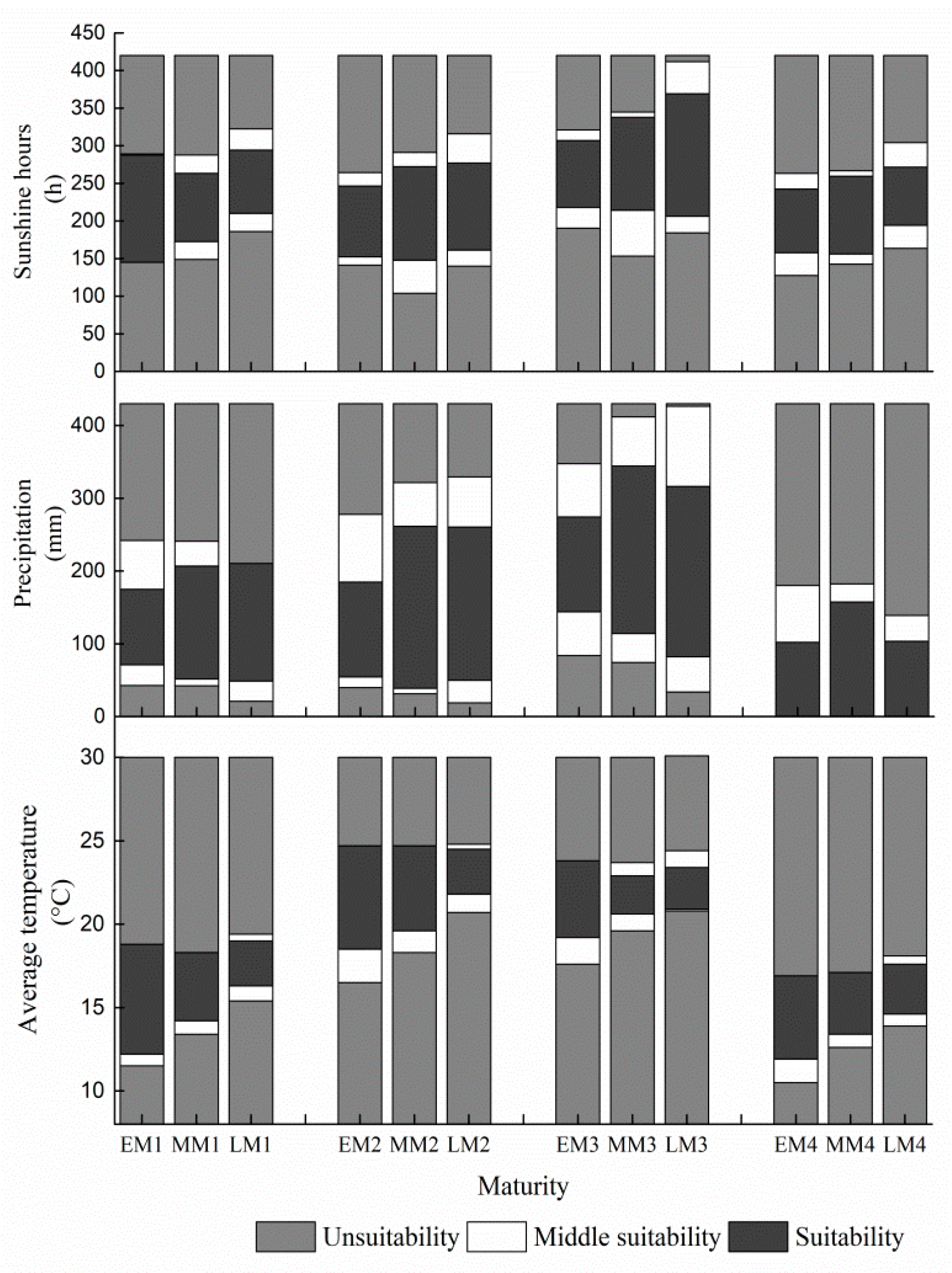
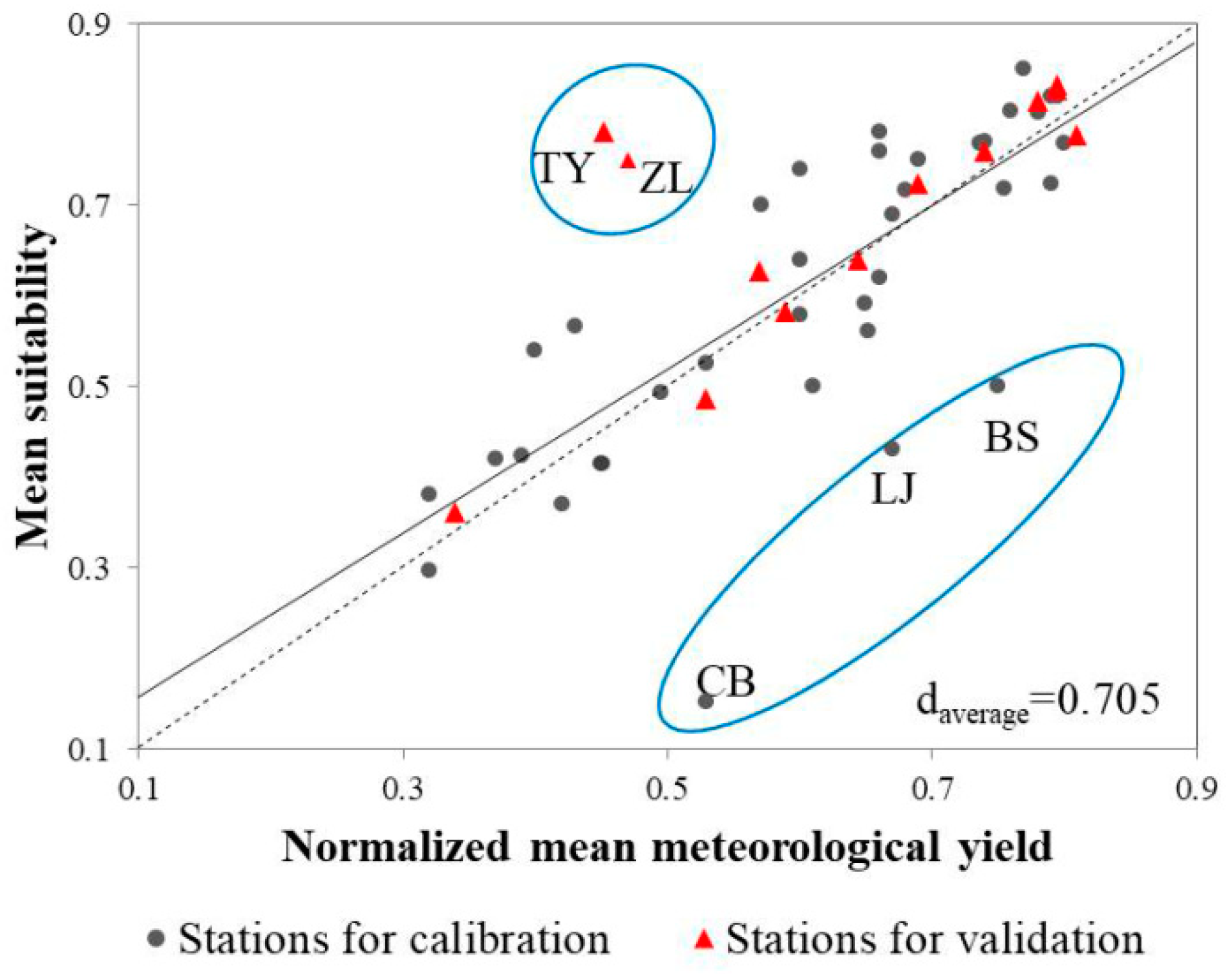

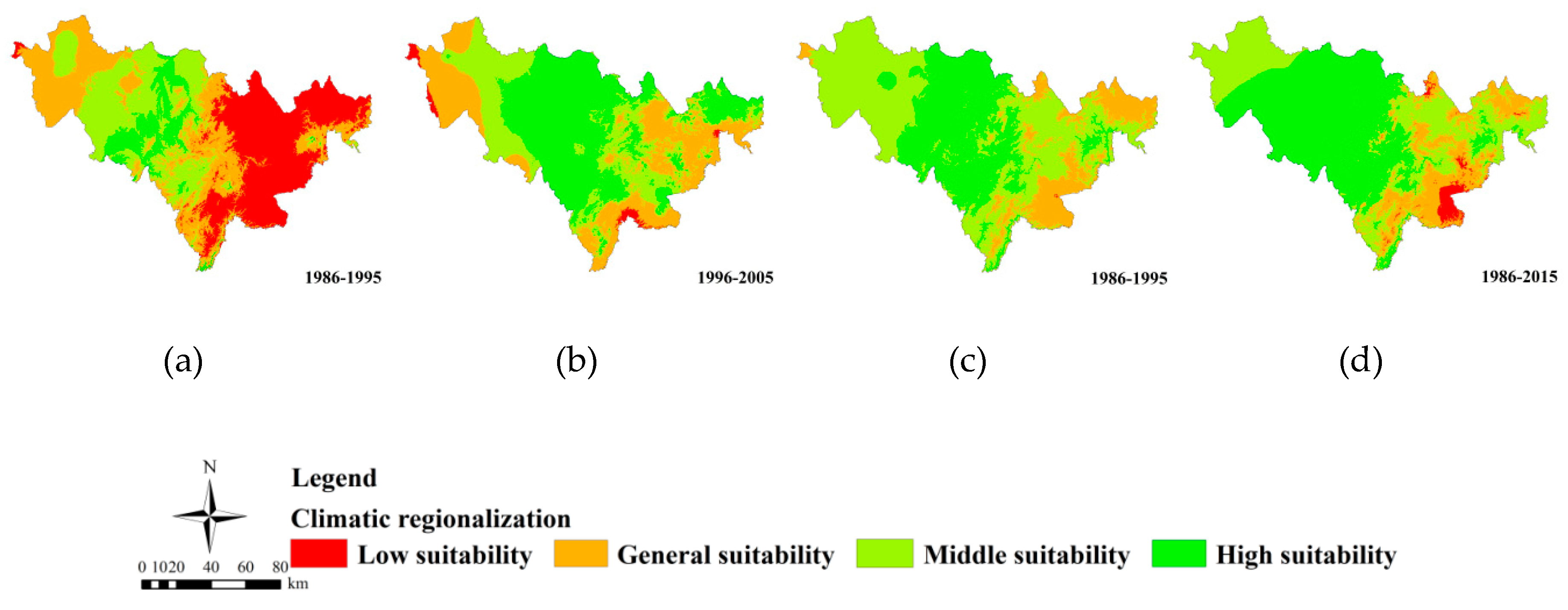


| Cultivation Area | ≥10 °C Accumulated Temperature (°C·d) (AAT10) |
|---|---|
| Unsuitable for planting (UP) | <2100 |
| Early maturity (EM) | 2100–2500 |
| Medium maturity (MM) | 2500–2850 |
| Late maturity (LM) | >2850 |
© 2019 by the authors. Licensee MDPI, Basel, Switzerland. This article is an open access article distributed under the terms and conditions of the Creative Commons Attribution (CC BY) license (http://creativecommons.org/licenses/by/4.0/).
Share and Cite
Zhao, J.; Li, K.; Wang, R.; Tong, Z.; Zhang, J. Yield Data Provide New Insight into the Dynamic Evaluation of Maize’s Climate Suitability: A Case Study in Jilin Province, China. Atmosphere 2019, 10, 305. https://doi.org/10.3390/atmos10060305
Zhao J, Li K, Wang R, Tong Z, Zhang J. Yield Data Provide New Insight into the Dynamic Evaluation of Maize’s Climate Suitability: A Case Study in Jilin Province, China. Atmosphere. 2019; 10(6):305. https://doi.org/10.3390/atmos10060305
Chicago/Turabian StyleZhao, Jing, Kaiwei Li, Rui Wang, Zhijun Tong, and Jiquan Zhang. 2019. "Yield Data Provide New Insight into the Dynamic Evaluation of Maize’s Climate Suitability: A Case Study in Jilin Province, China" Atmosphere 10, no. 6: 305. https://doi.org/10.3390/atmos10060305
APA StyleZhao, J., Li, K., Wang, R., Tong, Z., & Zhang, J. (2019). Yield Data Provide New Insight into the Dynamic Evaluation of Maize’s Climate Suitability: A Case Study in Jilin Province, China. Atmosphere, 10(6), 305. https://doi.org/10.3390/atmos10060305







